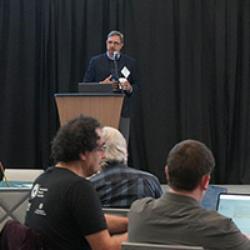Ganesh Subbarayan speaks at SRC meeting
July 7, 2025
Ganesh Subbarayan was invited by Semiconductor Research Corporation to speak at the SRC Annual Review/Celebration/Transitioning to SMART USA event at UT Dallas during June 3-5 where he gave a talk on his packaging research over the years and on the research at the SRC CHIRP center at Purdue.







